Kenya Coffee Bean SL28SL34 Variety K72 Coffee Bean characteristic Story of washing treatment
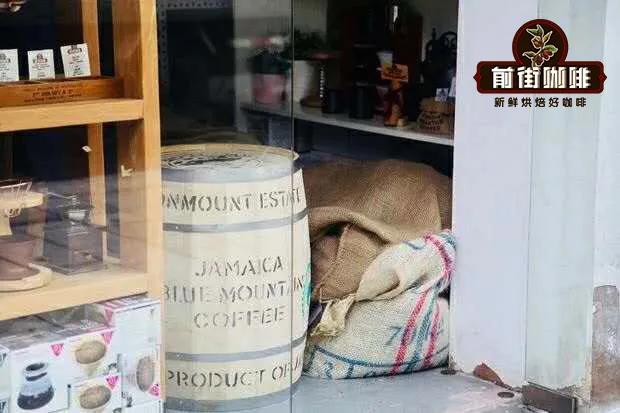
Professional coffee knowledge exchange more coffee bean information please follow the coffee workshop (Wechat official account cafe_style)
With the growth of the boutique coffee market, in addition to the common sun treatment and water washing treatment, a variety of treatments also appear in the field of vision of coffee fans, such as the Kenyan K72 water washing treatment, which is improved on the basis of water washing treatment. In this article, Qianjie Coffee will take a look at the Kenyan K72 treatment process.
What is the Kenyan K72 washing method?
As mentioned above in Qianjie Coffee, this treatment is improved on the basis of the traditional water washing method. Kenya first adopts the cyclic repeated treatment method of washing after fermentation, which is made after the same day of harvest, and the best quality coffee berries are selected for peeling and fermentation. the fermentation time is 24 hours, and 24 hours later use clean river water to wash. Then, it is fermented again with clean river water for 24 hours, then washed, and after 3 cycles, it reaches 72 hours, so it is called Kenyan 72-hour fermentation water washing treatment, referred to as K72 treatment.

K72 fermentation water washing treatment process:
The first washing and fermentation of ①
After the coffee berry harvest, the beans will first be picked by the specific gravity of the water flow, the principle is to use the difference in the density and quality of the coffee fruit itself to do screening; coffee beans with high density (heavy) will sink into the water, while coffee beans with low density will float. The coffee fruits with high mature quality have high density, so they are screened out for further treatment.
After the high-quality and ripe fruits are selected, the peel is removed, washed and soaked, and the pectin mucus attached to the outer layer of raw beans is fermented. Pectin has natural sugars and alcohols, which play an important role in the development of sweetness, acidity and overall flavor of coffee. The fermentation time is as long as 24 hours. after fermentation, 80-90% of the pectin can be removed, leaving only the flavor in the coffee beans.
The second washing and fermentation of ②
Then enter the second washing fermentation process, the coffee beans in the previous stage are washed and soaked in water for 24-48 hours. This process increases proteins and amino acids, and the acidity of coffee beans creates complex and delicate layers of taste. Finally, remove all remaining pectin and move the coffee beans to a high shelf for sun drying.

The fermentation time is as long as 24 hours. after fermentation, 90% of the pectin can be removed, leaving only the flavor of the coffee beans. finally, all the remaining pectin is removed and the coffee beans are moved to a high shelf for sun drying. the drying time depends on the weather conditions, which usually takes about 10 days to complete.
Qianjie believes that coffee beans treated with 72-hour fermentation water in Kenya are fermented for a long time at low temperatures and finally dried and dehydrated, giving the beans a brighter, cleaner and fuller flavor.
Growing conditions of coffee in Kenya
Of course, the quality of a coffee bean can not only depend on the quality of the treatment, but more importantly, the strength of the coffee bean itself is hard enough. The previous article of Qianjie Coffee often said that the flavor of a coffee bean depends on its coffee producing area, variety and treatment, that is to say, the quality of the treatment is based on the premise of high-quality coffee fruit.
Kenya is located in eastern Africa, the equator runs through the central part of the country, and the Great Rift Valley stretches north and south. It is bordered by Somalia to the east, Tanzania to the south, Uganda to the west, Ethiopia and Sudan to the north, and the Indian Ocean to the southeast. There are many plateaus in the territory, with an average elevation of 1500 meters. The central peak of Kirinaga (Mount Kenya) is 5199 meters above sea level and the top of the mountain is covered with snow, making it the second highest peak in Africa.
Kenya is a tropical region, with two rainy seasons a year and two harvests, with 60% concentrated from October to December and 40% from June to August. Coffee is mainly grown in volcanic areas from the capital Narobi to the mountains of Kenya at an altitude of 1600-2100 meters. This height is suitable for the development of coffee bean flavor, because the mountain temperature is lower, the growth is slow, the aroma components of coffee beans have been fully developed, the sour taste is more obvious, and the texture is harder. This fertile moonbend-shaped coffee area is the main producer of Kenyan boutique beans.
On the other hand, Qianjie Coffee often says that the growth conditions of Arabica coffee beans must be limited to altitude, and the higher the altitude, the better the flavor, the more acidic it will be. no wonder Kenyan coffee is famous for its excellent acidity.
But Kenya's sour coffee is very different from neighboring Ethiopian coffee. Coffee fans know that Ethiopian coffee beans in front street cafes are famous for their bright citrus lemon acidity, while Kenyan sour is more sour than virgin fruit. This is about to mention the flavor of its coffee variety.

Kenyan coffee bean varieties
The main varieties cultivated in Kenya are SL-28, SL-34, Ruiru11 and Batian. According to Qianjie Coffee, it is understood that these varieties are the products of the Kenya Coffee Research Institute.
SL-28,SL-34
SL actually stands for Scott Labs,Scott Laboratories, Scott Lab. In the 1930s, Scott Lab was commissioned by the Kenyan government to conduct research on the classification of coffee breeding, trying to find varieties that can adapt to Kenyan soil, can be used for large-scale cultivation and have commercial value. SL-28,SL-34 is one of many research results. The organization was active in the 1930s and 1960s, but it no longer exists.
The SL series, based on the ancient species of Mocha in Yemen and the bourbon species on the island of Reunion, now accounts for the majority of Kenyan coffee production, while SL-28 has a higher reputation, higher SL-34 harvests and slightly lower elevations.
According to botanists in SL laboratory, SL28 and SL34 are genetic variants. Among them, SL28 has the mixed pedigree of Moka and Yemeni Tibica. The goal of cultivating SL28 was to mass produce coffee beans with high quality and resistance to diseases and insect pests.
Although the yield of SL28 was not as large as expected, it has been spread to this day because of the copper leaf color and broad bean-shaped beans with great sweetness, balance and complex flavor, as well as significant citrus and black plum characteristics. This is the main reason why Kenyan coffee is rich in pleasant acidity.

While SL34 is similar to SL28 in flavor, except for its complex acidity and great sweetness, it is heavier, more full-bodied and cleaner than SL28. SL34 has bourbon and more Tibica blood. Beans look similar to SL28, but are more likely to survive, such as adapting to sudden heavy rain.
Ruiru11
Ruiru appeared after SL28 and SL34, and Qianjie learned that it was in the 1970s, when Ruiru began to try to cultivate different CBD and rust-resistant varieties. The result is Ruiru11, which was released in the 1980s. High yield, CBD and antirust properties seem to be the solution to all coffee production problems in Kenya.
Batian
The Batian variety was launched by the Coffee Research Institute (CRI) on September 8, 2010. it is also the latest variety offered in Kenya. It is a further experiment based on lessons learned from Ruiru11. Genetically speaking, it is essentially selected from the backcross between SL28 and SL34, and is closer to SL28 than Ruiru 11. Thus, this eliminates the elements of the problematic Robusta varieties of coffee beans, thus improving the quality of cup testing.
Kenya Coffee Bean grading system
Kenya is graded according to the particle size and cup test results of coffee beans. According to the size, shape and hardness of coffee beans, from high to low is AA or AA+, AB, PB, C, E, TT, T. For the raw coffee beans of AA grade and AB grade, the special classification of cup test results (not officially recognized by Kenyan countries, made by exporters) is added, and the order from high to low is TOP, PLUS (+) and FAQ.
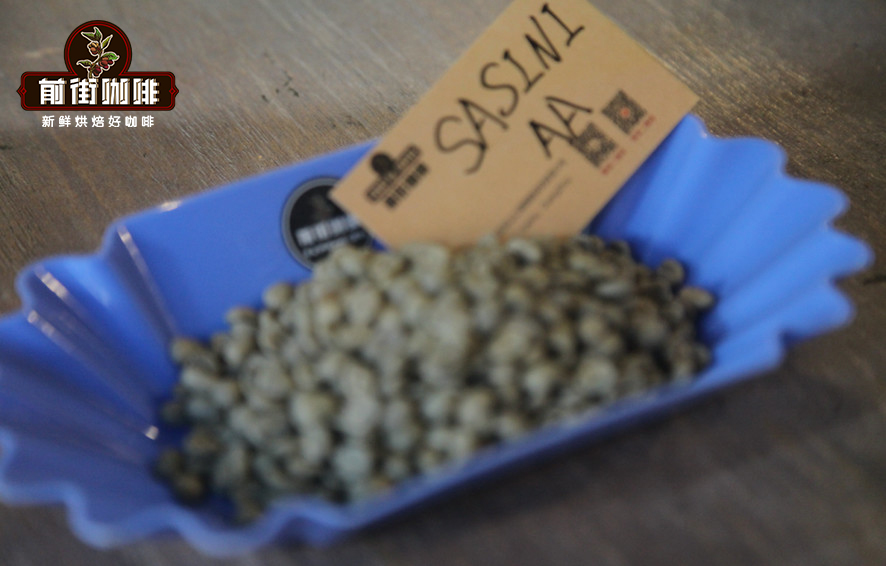
AA grade with excellent quality (flavor, taste) in AA Plus (AA+) cup.
AA particles: size (Screen Size) 17-18 mesh.
AB particles: size (Screen Size) 15-16 mesh, accounting for the majority of output.
C particles: those whose size (Screen Size) is smaller than AB.
TT from AA and AB beans: lighter beans blown out with an airflow filter.
T from Class C beans: lighter beans blown out with an airflow filter.
E Elephant Bean: two beans into one of the large mutant beans, also known as elephant ear bean Elephant ear.
PB Peaberry: classified by appearance, independent of flavor weight.
According to Shangqianjie Coffee, both the treatment method and the coffee producing area and variety have more or less influence on the flavor of coffee beans, and the Kenyan producing area itself is very suitable for growing coffee beans. K72 water washing treatment developed is also an icing on the cake to the flavor of coffee beans, and multiple washing also makes the flavor of coffee beans cleaner and brighter. This is why Kenyan coffee beans have a bright sour flavor similar to that of virgin fruits.
Next, Qianjie will introduce to coffee fans all the Kenyan coffee beans and roasting data analysis of Qianjie coffee.
Front street coffee Kenya Azaria coffee beans
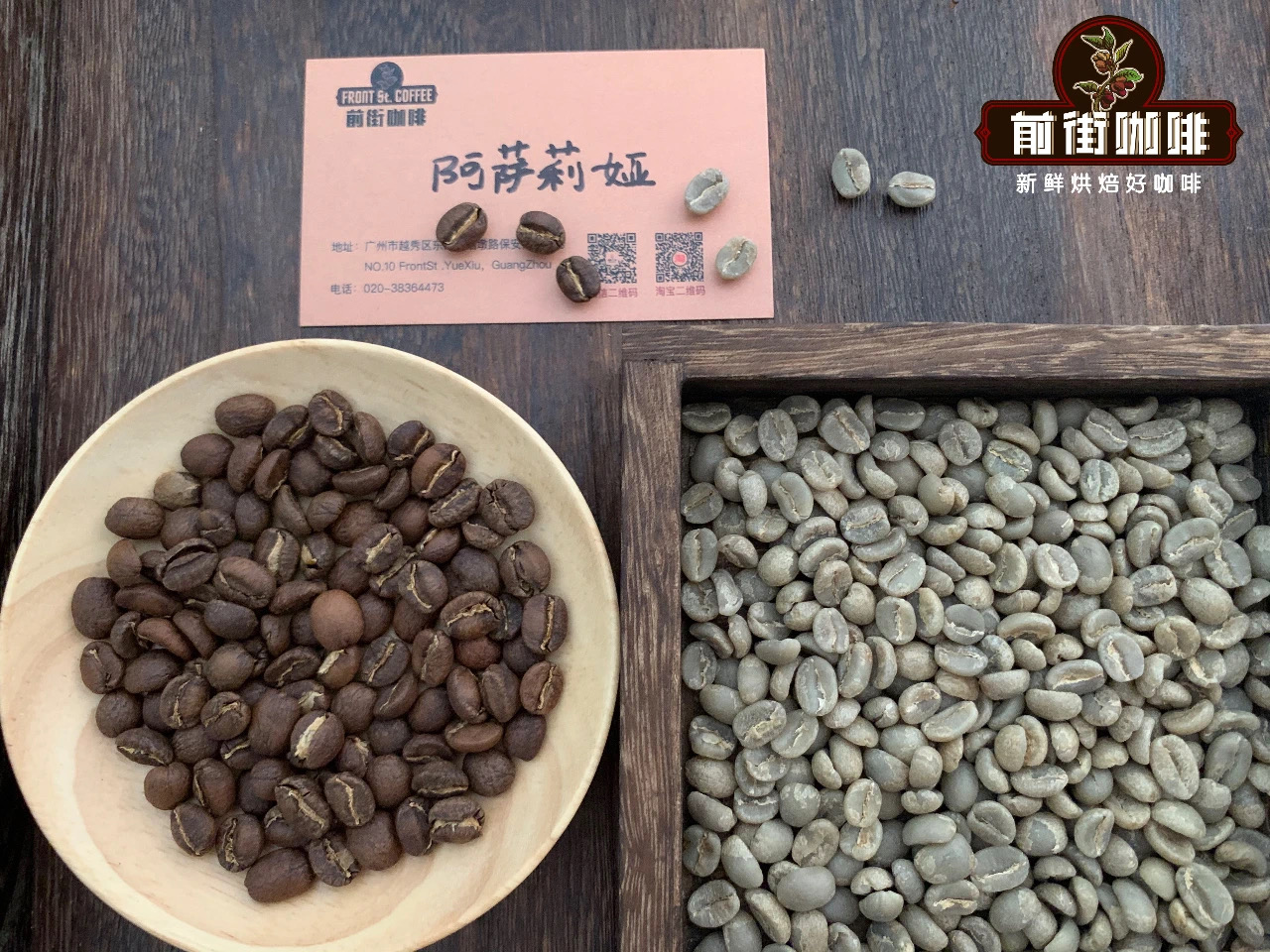
Country: Kenya
Production area: Asali (Honey processing Plant)
Altitude: 1550-1750m
Variety: SL28,SL34
Treatment method: 72 hours washing treatment
Flavor: Sydney, black plum, brown sugar, virgin fruit, Brin
Front Street Coffee Roast record of Asaria Coffee beans in Kenya
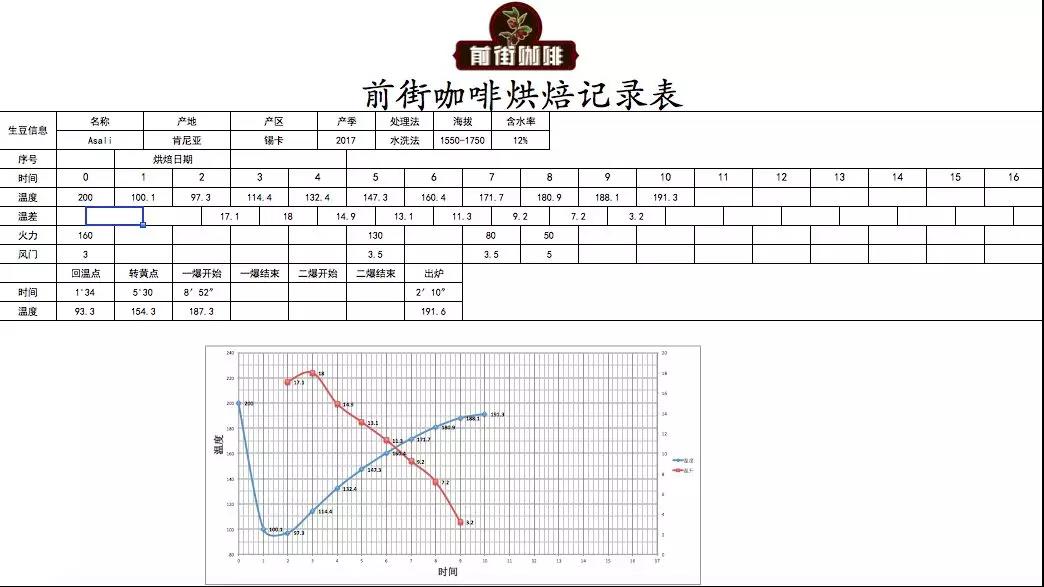
This bean is full and round, and Qianjie coffee is roasted lightly in order to fully show its bright and mellow acidity. Yangjia 800N semi-direct fire, bean dosage 480g: furnace temperature to 160 degrees Celsius into the pot, throttle open 3, firepower 120. Temperature recovery point: 1 temperature rising to 130 degrees, throttle opening 4. Baking to 6: 00 ", temperature 154.6 degrees, bean surface turns yellow, grass smell disappears completely, dehydration is complete.
When the bean surface appears ugly Hu wrinkles and black markings, the smell of toast obviously changes to the smell of coffee, which can be defined as a prelude to an explosion. At this time, it is necessary to listen carefully to the sound of the explosion point, to 9: 28 ", the throttle remains the same, and the development time of the explosion is 2: 20". Put the pot at 193.8 degrees.
Suggestion on brewing coffee in Qianjie
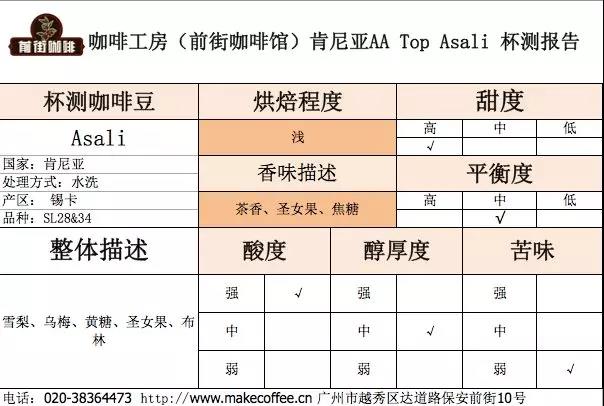
Filter cup: Hario V60
Water temperature: 90 ℃
Amount of powder: 15g
Powder / water ratio: 1:15
Degree of grinding: BG#6s (76% of the pass rate of Chinese standard No. 20 screen)

Qianjie coffee brewing technique: use 30 grams of water for steaming for 30 seconds, small water flow round the circle to 125 grams for segments, when the water level is about to expose the powder bed, continue to inject water to 225 grams to stop water injection, wait for the water level to drop and remove the filter cup when the powder bed is about to be exposed, (the time of steaming starts) the extraction time is 2 minutes 39 percent 00 ".
Flavor description: the wet fragrance has ripe tomato and flower aromas, imported virgin fruit and black plum flavor, bright acidity, clean and rich taste, outstanding sweetness in the middle, fruit juice, raspberry and yellow sugar on the finish, and green tea aroma.
Front Street Coffee PB Coffee beans in Sassini Estate, Kenya

Country: Kenya
Producing area: Sassini Manor
Altitude: 1680m
Variety: SL28,SL24,riuru
Treatment method: 72 hours washing treatment
Flavor: Virgin fruit, almonds, black plums, honey, grapes
Roasting Analysis of Kenya Sassini pb Coffee Bean in Front Street Coffee
This full-bodied coffee bean due to high altitude, hard beans, at first with a higher temperature climb, turn yellow point in about 5 minutes, and then reduce the firepower into the Mena reaction, again reduce the firepower to prolong the Mena reaction time. When the first burst begins, it is highly endothermic, so it is recommended to maintain heat at this stage to prevent stagnation. The development of first explosion takes more time, which is helpful to reduce acidity and develop flavor.

Roaster Yangjia 800N (baking capacity 300g)
The furnace temperature is 170℃ and the firepower is 100. the throttle is opened at 390 ℃, and the firepower remains unchanged. When the furnace temperature is 149℃, the bean meter turns yellow, the grass smell disappears completely, and enters the dehydration stage.
7: 14 "after dehydration, the firepower and throttle remain the same." 7: 30 "is the appearance of wrinkles and black markings on the bean table, and the smell of toast changes to coffee, which is a prelude to an explosion. At 8 '20`, the blast begins, the throttle opens 4, and the firepower is reduced to 50. After an explosion, the development time is 1: 50 ". At 188 ℃, the firepower is reduced to 30, and the temperature rises to 193.3 ℃.
Suggestion on brewing coffee in Qianjie

Filter cup: V60 or cake cup
Water temperature: 90-91 ℃
Powder / water ratio: 1:15
Degree of grinding: fine grinding (the pass rate of Chinese standard No. 20 screen is 80%)
Flushing and cooking technique: segmented extraction. Steam with 30 grams of water for 30 seconds, small water flow around the circle to 124 grams for sectional injection, when the water level is about to expose the powder bed, continue to inject water to 228 grams to stop injection, and so on when the water level drop is about to expose the powder bed, remove the filter cup, (the time of steaming starts) the extraction time is 1 minute 39 percent 55 ".
When boiled in a V60 filter cup, it smells floral, with sour notes of virgin fruit, citrus, nuts, cream in the middle, brown sugar, cocoa and oolong tea. The flavor level is relatively rich, the flower smell is obvious; when cooking with the cake filter cup, it smells herbaceous and virgin fruit, the overall fruit juice feeling is obvious, the sour taste is more lively.
For more boutique coffee beans, please add private Qianjie coffee on Wechat. WeChat account: kaixinguoguo0925
Important Notice :
前街咖啡 FrontStreet Coffee has moved to new addredd:
FrontStreet Coffee Address: 315,Donghua East Road,GuangZhou
Tel:020 38364473
- Prev

What is the formula proportion of commercial Italian coffee beans? how to mix Italian roasted coffee beans
Professional coffee knowledge exchange more coffee bean information please pay attention to the coffee workshop (Wechat official account cafe_style) espresso beans in the variety, production areas, treatment collocation, for the production of a cup of espresso has a very great impact, the following will tell you about the general Italian blending coffee beans use common production areas how to mix individual coffee beans. Many people like to drink lattes.
- Next
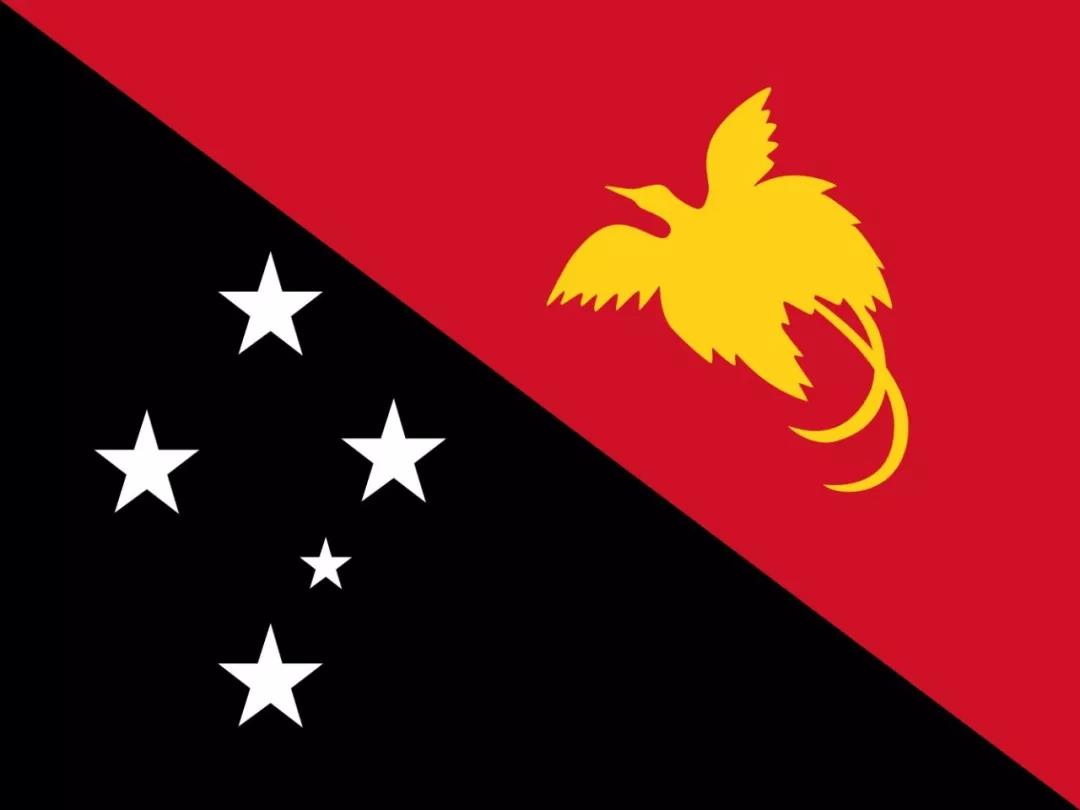
Papua New Guinea Paradise Bird Coffee beans feature Jamaican Iron Card Asian Little Blue Mountain Story
01 | the people of Papua New Guinea regard the beautiful bird of paradise as a bird of freedom and joy, a gift from the gods. PNG AA Sigri Manor Arabica Coffee, like the migration of birds, was bred from the Jamaican Blue Mountain Ironka to Papua New Guinea, with the same ancestry of the Jamaican Blue Mountains. In Papua New Guinea, coffee is
Related
- Detailed explanation of Jadeite planting Land in Panamanian Jadeite Manor introduction to the grading system of Jadeite competitive bidding, Red bid, Green bid and Rose Summer
- Story of Coffee planting in Brenka region of Costa Rica Stonehenge Manor anaerobic heavy honey treatment of flavor mouth
- What's on the barrel of Blue Mountain Coffee beans?
- Can American coffee also pull flowers? How to use hot American style to pull out a good-looking pattern?
- Can you make a cold extract with coffee beans? What is the right proportion for cold-extracted coffee formula?
- Indonesian PWN Gold Mandrine Coffee Origin Features Flavor How to Chong? Mandolin coffee is American.
- A brief introduction to the flavor characteristics of Brazilian yellow bourbon coffee beans
- What is the effect of different water quality on the flavor of cold-extracted coffee? What kind of water is best for brewing coffee?
- Why do you think of Rose Summer whenever you mention Panamanian coffee?
- Introduction to the characteristics of authentic blue mountain coffee bean producing areas? What is the CIB Coffee Authority in Jamaica?

